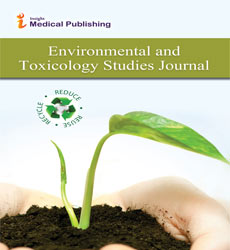Biomarkers of Environmental Pollutant Exposure: Advances in Toxicological Monitoring and Public Health Applications
Micol Choi*
Department of Environmental Science and Engineering, Tongji University, Shanghai, China
*Corresponding author:
Micol Choi,
Department of Environmental Science and Engineering, Tongji University, Shanghai, China,
E-mail: micol@choi.cn
Received date: February 01, 2025, Manuscript No. IPETSJ-25-20609; Editor assigned date: February 03, 2025, PreQC No. IPETSJ-25-20609 (PQ); Reviewed date: February 15, 2025, QC No. IPETSJ-25-20609; Revised date: February 22, 2025, Manuscript No. IPETSJ-25-20609 (R); Published date: February 28, 2025, DOI: 10.36648/.9.1.1
Citation: Choi M (2025) Biomarkers of Environmental Pollutant Exposure: Advances in Toxicological Monitoring and Public Health Applications. Environ Toxicol J Vol.9 No.1:1
Introduction
Environmental pollutants, including heavy metals, persistent organic compounds, and airborne particulates, pose significant threats to human health and ecosystems. Biomarkersâ??measurable indicators of exposure, effect, or susceptibilityâ??have emerged as essential tools in toxicological monitoring, enabling early detection of pollutant-related physiological changes before clinical symptoms appear. Advances in analytical techniques, molecular biology, and high-throughput screening have expanded the scope and sensitivity of biomarker identification, facilitating more precise exposure assessment. This article explores recent progress in biomarker-based monitoring of environmental pollutants and their implications for public health interventions, risk assessment, and regulatory decision-making [1].
Description
Recent developments in biomarker discovery have focused on molecular-level indicators such as gene expression profiles, epigenetic modifications, and protein signatures that respond to specific environmental toxins. For example, heavy metal exposure can alter metallothionein expression or induce oxidative stress markers, providing sensitive measures of toxic burden. Similarly, exposure to polycyclic aromatic hydrocarbons and other organic pollutants can be detected through changes in cytochrome P450 enzyme activity or DNA adduct formation. These molecular biomarkers offer high specificity and enable early intervention, enhancing both occupational and population-level health surveillance [2].
In addition to molecular biomarkers, physiological and biochemical indicators remain integral to monitoring pollutant exposure. Parameters such as blood or urinary metal concentrations, lung function tests for air pollutants, and livenzyme alterations for industrial chemicals provide quantifiable evidence of systemic impact biological behavior such as activation by cellular reductants light [3].
Integration of these classical biomarkers with modern molecular approaches allows for a multi-dimensional assessment, improving accuracy and reliability in detecting both acute and chronic exposures. The combination of exposure-specific and effect-based markers strengthens the linkage between environmental presence of pollutants and tangible health outcomes [4].
The application of biomarkers in public health policy and environmental management has expanded significantly. Biomarker data support risk assessment frameworks, guide regulatory limits for chemical exposure, and inform remediation strategies. Population-wide bio monitoring programs, leveraging both molecular and biochemical markers, enable early detection of emerging environmental threats and identification of vulnerable groups. Moreover, advances in non-invasive sampling methods, such as hair, saliva, or exhaled breath condensates, enhance participation and feasibility, facilitating longitudinal studies critical for public health planning and epidemiological research facilitating longitudinal studies critical for public health planning and epidemiological research [5].
Conclusion
Biomarkers of environmental pollutant exposure represent a powerful intersection of toxicology, molecular biology, and public health. Advances in detection technologies and multi-level biomarker strategies provide sensitive and specific measures of exposure, effect, and susceptibility, improving early intervention and risk management. By integrating biomarker data into public health policy, environmental monitoring, and epidemiological studies, societies can better identify at-risk populations, implement targeted interventions, and ultimately mitigate the adverse health effects of environmental pollutants.
Acknowledgement
None.
Conflict of Interest
None.
References
- Leusch FDL, Allen H, De Silva NAL, Hodson R, Johnson M, et al. (2024) Effect-based monitoring of two rivers under urban and agricultural influence reveals a range of biological activities in sediment and water extracts. J Environ Manag 351: 119692
Google Scholar Cross Ref Indexed at
- Zhang X, Xia P, Wang P, Yang J, Baird DJ (2018) Omics advances in ecotoxicology. Environ Sci Technol 5: 3842–3851
Google Scholar Cross Ref Indexed at
- Pawlowski J, Kelly-Quinn M, Altermatt F, Apotheloz-Perret-Gentil L, Beja P, et al. (2018) The future of biotic indices in the ecogenomic era: Integrating (e)DNA metabarcoding in biological assessment of aquatic ecosystems. Sci Total Environ 637: 1295–1310
Google Scholar Cross Ref Indexed at
- Tong WD, Ostroff S, Blais B, Silva P, Dubuc M, et al. (2015) Genomics in the land of regulatory science. Regul Toxicol Pharmacol 72: 102–106
Google Scholar Cross Ref Indexed at
- Garcia-Reyero N, Perkins EJ (2011) Systems biology: Leading the revolution in ecotoxicology. Environ Toxicol Chem 30: 265–273
Open Access Journals
- Aquaculture & Veterinary Science
- Chemistry & Chemical Sciences
- Clinical Sciences
- Engineering
- General Science
- Genetics & Molecular Biology
- Health Care & Nursing
- Immunology & Microbiology
- Materials Science
- Mathematics & Physics
- Medical Sciences
- Neurology & Psychiatry
- Oncology & Cancer Science
- Pharmaceutical Sciences
